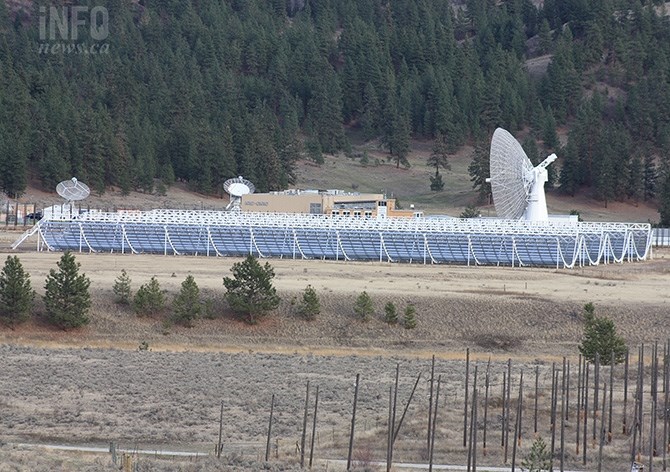
Dominion Radio Astrophysical Observatory's CHIME telescope.
(STEVE ARSTAD / iNFOnews.ca)
January 09, 2020 - 2:00 PM
Astronomers at the South Okanagan’s Dominion Radio Astrophysical Observatory recently collaborated with eight other radio telescopes around the world to pinpoint the location of a fast radio burst first discovered by the observatory’s CHIME telescope last year.
Paul Scholz, who has a post doctoral fellowship with the University of Toronto was on hand at observatory — on White Lake Road south of Penticton — this week. He describes fast radio bursts as millisecond long pulses of radio light from far outside our Milky Way Galaxy.
“We don’t currently know what causes them. Because they are so short and so far away, we suspect they come from the densest objects in the universe, black holes and neutron stars. Those come about when a star dies and goes supernova, and you’re left with the core of a dense star,” Scholz says.
The CHIME (Canadian Hydrogen Intensity Mapping) telescope at the observatory discovered this source about a year ago and in the past year, CHIME, along with European radio telescope collaborators have pinpointed the source of the fast radio burst discovered last year. Eight telescopes spanning the world from the United Kingdom to China were also involved in the discovery.
Since CHIME began operating in 2018 the telescope has discovered dozens of fast radio bursts, accelerating the rate of discovery of the phenomena, Science News said in a recent article.
Scholz says CHIME sees only a “single pixel” in the sky, so this localization using radio telescopes spread out around the world allowed the scientists to pinpoint not only which galaxy but where in the galaxy the fast radio burst was originating from.
“We don’t know how objects like black holes and neutron stars cause fast radio bursts. It’s an interesting puzzle in astronomy right now,” Scholz says, adding the discovery is teaching astronomers more about the environment fast radio bursts come from.
This recent breakthrough is only the second time scientists have been able to precisely locate a repeating source of a fast radio burst.
To contact a reporter for this story, email Steve Arstad or call 250-488-3065 or email the editor. You can also submit photos, videos or news tips to tips@infonews.ca and be entered to win a monthly prize draw.
We welcome your comments and opinions on our stories but play nice. We won't censor or delete comments unless they contain off-topic statements or links, unnecessary vulgarity, false facts, spam or obviously fake profiles. If you have any concerns about what you see in comments, email the editor in the link above.
News from © iNFOnews, 2020